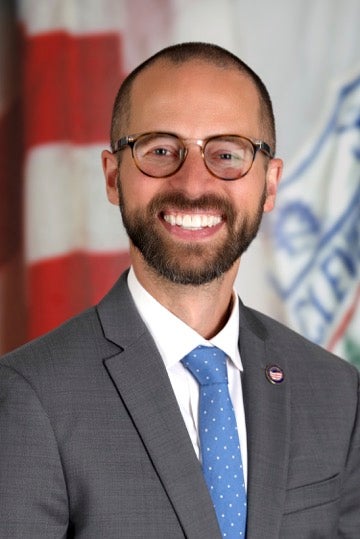A Fierce Collaborator, Dr. Margolius’ Laser Focus on Health Priorities for Cleveland Will Help Eliminate Health Disparities
This article is a part of our CTSC Translational Science Superheroes series.
Dr. David Margolius had a long-term goal of working in public health or policy to help change the built environment. Being the Director of the Cleveland Department of Public Health was serendipitous as he was prompted to apply by friends and colleagues when the posting went live last year. Growing up in Shaker Heights, he knew he wanted to be a doctor early on in his life. “I fell in love with the ability to study and understand science and help people,” Dr. Margolius said. He thought about global health work halfway through medical school, but explained that he felt a white guy doing global health work didn’t land the right way when there people were already doing great work around the world. “It was more important to help them and prop up the work they were doing,” Dr. Margolius added.
Invested in primary care and the primary care system, Dr. Margolius described primary care as “the most important part of the system to impact the health of the community.” He went to San Francisco to study with people who were researching best models in primary care. “I lived in San Francisco for six years, met my wife there, and when she was eight months pregnant, we decided to move back to Cleveland,” Dr. Margolius said. Coming back to Cleveland and working at a safety net hospital system, MetroHealth, was not by chance. “I loved taking care of people as their primary care doctor. I earned opportunities to make a difference on the system level and enjoyed that, too,” Dr. Margolius explained.
Dr. Margolius researched the greatest threats to public health when interviewing for the job with Mayor Bibb. Although the list has evolved, cars, lead poisoning, fentanyl, Black infant and maternal mortality, gun violence, and smoking remain core issues. Smoking is the most preventable cause of death worldwide. “Cleveland has one of the highest–if not the highest–smoking rates in the country at 35%,” Dr. Margolius shared. “Where the rest of the country went from 20% to 12.5% over the past 20 years, Cleveland’s rate increased from 30% to 35%,” he added.
When Dr. Margolius joined the city, there was not enough spotlight on this issue. He asked, “What can we do to make the biggest difference on this issue?” Early on, he asked who was doing the work and people like Dr. Erika Trapl at Case Western Reserve University and Yvonka Hall at the Northeast Ohio Black Health Coalition came up in conversation. Research proved that places that have laws restricting the sale of flavored tobacco have seen a 20% reduction in smoking. Big tobacco, historically, targeted youth, Black and Latino/a smokers, and the LGBT+ community with flavored products. The City of Columbus passed a flavored tobacco sales restriction that will go into effect in 2024. And in February 2023, the Cleveland Department of Public Health asked Cleveland City Council to introduce a ban on sales of flavored tobacco products.
Although the health benefits would be immense, there is pushback from convenient store owners regarding the threat to business. “There are 600 tobacco retailers–1 per 620 people–in Cleveland,” Dr. Margolius advised. He added, “Big tobacco spends $430M per year on advertising or promotions. Public health cessation resources cap at $14M which is why we need to not only inform, but also leverage policy.”
Advice to Researchers
Dr. Margolius’ advice to researchers is to:
- Focus on the City’s priority of reversing the impacts of structural racism on health
- Show impact in five years or less to best convince government at every level why the investment in health is needed and how your intervention has proven effective
- Build coalitions (like models we’ve seen with community collaboration to impact Black infant mortality and lead poisoning)
Advocacy Ideas
Simple advocacy efforts to support the work include:
- Writing letters to the editor in newspapers
- Giving public comment at City Council meetings
- Making phone calls to legislators
- Educating friends about topics
“I try to lead with love–not fear. We are here to help people quit and ideally, not start [smoking],” Dr. Margolius emphasized.
Fast Five
- Favorite thing to do in Northeast Ohio: Volleyball
- Favorite research innovation: Integrated Behavioral Health
- Favorite restaurant: Harlow’s Pizza
- Favorite place to go in Northeast Ohio: Brookside Reservation in the Old Brooklyn neighborhood of Cleveland
- If I wasn’t a Director of Public Health, I’d be…: Indiana Jones



